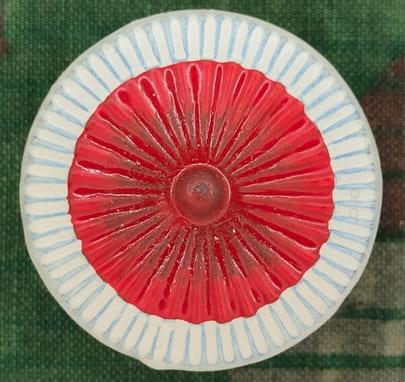 Flagge "Flagge des Kanton Nidwalden" bei fahnenversand.de kaufen.
Flagge "Flagge des Kanton Nidwalden" bei fahnenversand.de kaufen.
 Flagge "Flagge des Kanton Nidwalden" bei fahnenversand.de kaufen.
Flagge "Flagge des Kanton Nidwalden" bei fahnenversand.de kaufen.
Last modified: 2025-03-22 by martin karner
Keywords: switzerland | nidwalden | canton | half canton | key | german |
Links: FOTW homepage |
search |
disclaimer and copyright |
write us |
mirrors
Gules, a double-key in pale ward up and addorsed argent.
On a red field, a white upright key with two shanks facing outwards
and connected to one grip.
T.F. Mills, 16 October 1997
Original Kräpfligriff grip.
Antonio Martins, 11 December 1997
Simple rectangular cantonal flag, as shown in Mader (1942) (So-called
colour flag [Farbenfahne in German]).
Martin Karner
See also: STATE COLOURS in Dictionary of Vexillology
Flaggen, Knatterfahnen and Livery Colours |
![[Knatterfahnen]](../images/c/ch-nw_f.gif)
|
![[Knatterfahnen]](../images/c/ch-nw_kf.gif) images by Pascal Gross
images by Pascal Gross
|
Flaggen are vertically hoisted from a crossbar in the manner of gonfanon, in ratio of about 2:9, with a swallowtail that indents about 2 units. The chief, or hoist (square part) usually incorporates the design from the coat of arms – not from the flag. The fly part is always divided lengthwise, usually in a bicolour, triband or tricolour pattern (except Schwyz which is monocolour, and Glarus which has four stripes of unequal width). The colours chosen for the fly end are usually the main colours of the coat of arms, but the choice is not always straight forward.
Knatterfahnen are similar to Flaggen, but hoisted from the long side and have no swallow tail. They normally show the national, cantonal or communal flag in their chiefs.
Željko Heimer, 16 July 2000
See also: HANGING FLAG, VERTICALLY HOISTED FLAG, LIVERY COLOURS in Dictionary of Vexillology
logo.jpg) image located by Martin Karner (8 May 2024)
image located by Martin Karner (8 May 2024) image located by Martin Karner
image located by Martin KarnerCockade for the cantonal troops' headgear (regulation from 1898, size: ca. 35 mm, reverse side).
Martin Karner, 14 March 2025
See also: Cockades (Swiss Army)
– Banner of Nidwalden, carried in the Burgundian Wars (1474–77) (source: [b7b42]).
– Julius Banner (1512), drawing. The defacements of the keys and the Zwickelbild have been removed and are
missing. The Latin writing along the four borders of the banner reads as follows: "IHS ANNO A NATIVITATE
CHRISTI CCCLXXXVIII POPVLVS VNDERIVALDLEN (!) SVBTVS NEMVS SVB ANASTASIO PAPA PRO FIDE CRISTIANA IN VRBE
ROMANA FELICITER PVGNANS INSIGNVM VICTORIE AC PREMIVM VIRTVSTIS (!) EC (!) ARMORVM INSIGNIA OBTINVIT
QUE POSTEA A IVLIO SECVNDO PONTIFICE MAXIMIANO (!) PREDICTO POPVLO PRO LIBERTATE ECCLESIE IN
LOMBARDIA PVGNANTI ANNO SALUTIS CRISTIANE MDXII CONFIRMATA" (Transl.: "In the year of the
Christian era 388, the people of Unterwalden below the forest [= Nidwalden] fought bravely
under Pope Anastasius for the Christian faith in the city of Rome and received this coat of
arms [armorum insignia] as a symbol of victory and reward for their bravery, which were later
confirmed by Julius II, the Maximian pontiff, to the aforesaid people for the freedom of the church
in Lombardy in the year of Christian salvation 1512"). This inscription
is based on the legend about the origins of the keys in the two flags of Unterwalden:
"When the Goths under their king Alaric were harassing Italy and were already approaching
its capital, the pope and emperor, in need and distress, sent for help to the inhabitants of
the primeval mountains. Their lively youth immediately rushed over the mountains, lined up
under the banners of Emperor Honorius and courageously and powerfully helped to repel the
advancing enemy from the walls of the capital of Christianity. For such a laudable feat of
arms, Emperor Honorius declared the three countries of Uri, Schwyz and Unterwalden as liberated
from all princely rule. Pope Anastasius I, who was sitting on Peter's chair at that time, also
expressed his gratitude and sent precious standards and war banners to each of the three
mountain valleys. The field banner issued to the people of Unterwalden had a double, white,
upright key in a red field."
The very same inscription on the banner of Nidwalden appeared – without spelling errors –
some decades later "suddenly" also on the Julius Banner of Obwalden (some suppose in 1552),
with the only difference that "Nidwalden" was replaced by "Obwalden" ("VNDERWALDEN
SVPRA NEMVS"). Probably the Obwaldners argued that they had the right to do this because in
the legend of the keys both countries are mentioned as "Unterwalden". Nevertheless the
operation was a scam, the inscription was not part of the original banner donated by Pope Julius
(sources: [mro42], [b7b42]).
– Stained glass plate of Nidwalden (1564). Flag bearer with Nidwalden flag and trefoil with coats of arms of
Obwalden, Nidwalden and the Holy Roman Empire (as a sign of imperial immediacy). Presumably the right half of a status disc showing both Obwalden
and Nidwalden. Nidwalden had used the double key as a pattern for its war flag since the early 15th century. The red and white pattern that used
to represent Unterwalden as a whole was now used by Obwalden. Location: Sułkowski Castle in Bielsko-Biała, Poland (source).
– Banner of Nidwalden (ca. 1601), gift from Landammann (governor) Johannes Waser to the state of
Nidwalden, silk damask, key made with gold and silver brocade, Zwickelbild with Jesus on the cross with
John and Mary. Location: town hall, Stans (source).
– Flag of Nidwalden (18th c., b/w photo) (source: [b7b42]).
– Flag of Nidwalden (1802). Made for and used in the Stecklikrieg
(rebellion against the Helvetic Republic).
Inscription: "Für Gott und Vaterland. | Siegen oder Sterben." (For God and Fatherland | To win or to die)
(source).







